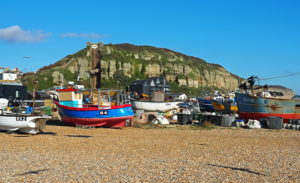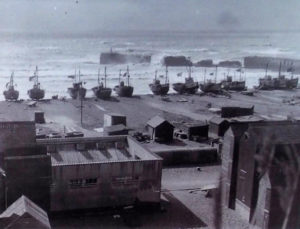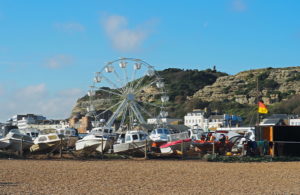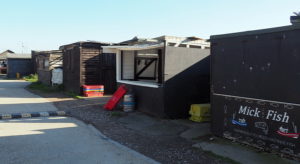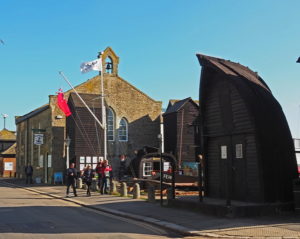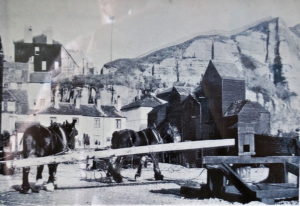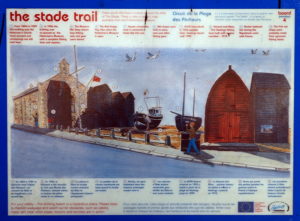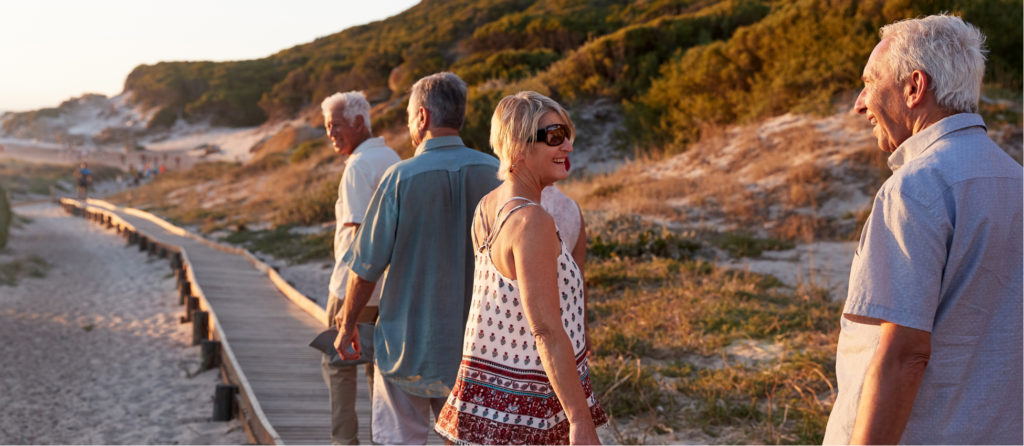Although it was one of the Cinque Ports, Hastings has never had a good harbour and has always been in danger of coastal erosion. Boats have traditionally been stored and launched from the beach.
Fishing has always been an important part of the economy of Hastings. It still has the largest beach launched fishing fleet in the country, with over 25 boats based on the Stade an Anglo Saxon word meaning launching place.
By the start of the C19th, Hastings was beginning to develop as a fashionable sea side resort and this lead to a series of clashes between the fishermen and the corporation.
In 1834, the first sea defence groyne was built beneath the cliffs at Rock-a-Nore, to protect the old town from increasing flooding by the sea. A large amount of shingle pilled up on the west side of the groyne, increasing the amount of usable beach. This was rapidly developed into a fishing area with fishing boats along with their net shops for storing equipment based along here with the fish market.
The Stade is still the base for the fishing fleet. Just to the west, pleasure boats are berthed on the beach with the boating lake and amusement parks.
Boats were originally hauled up onto the beach above high tide mark using horse capstans. These had an oak frame with an elm winding drum. A hawser was attached to the capstan and then hooked onto a small hole at the bottom of the bows of a boat. A horse was tied to the capstan’s long bar and walked in circles winding the hawser round the large central post. Two horses were used for larger boats. The horses were owned by the Corporation and stabled in what is now the Shipwreck Museum. They have now been replaced by motor driven winches in small tarred sheds, or tractors.
This area was also used to mend nets and sails. Fishermen’s wives would take in laundry from local guest houses to supplement income and would hang it out to dry between the boats. Fish is still sold from shacks along Rock-a-aNore.
Behind these are the “net shops.”:https://www.silvertraveladvisor.com/review/place/210694-review-hastings net shops (see separate review). These form double rows with large gaps between allowing boats could be hauled up close to the cliff.
In the C18th and early C19th, smuggling was rife along the coast and, if a fisherman was caught, his boat would be confiscated and sawn in two. Many of the half boats were used as stores, or even as primitive living quarters. Half Sovereign Cottage outside the Fisherman’s Museum is a modern reconstruction made for the museum. The other half of the boat is a net shop.
There is so much to see and there are a series of information boards about the history of the Stade. It is an attractive area to ecxplore on foot and there is also the “Fisherman’s Museum”:https://www.silvertraveladvisor.com/review/attraction/210696-review-fishermans-museum and the “Shipwreck Museum “:https://www.silvertraveladvisor.com/review/attraction/210698-review-shipwreck-museum – both worth visiting.
There are more photographs “here”:https://www.sloweurope.com/community/threads/hastings-and-its-fishing-heritage.6155/ .
